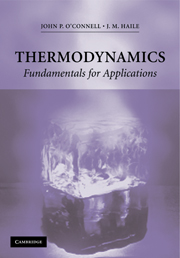Book contents
- Frontmatter
- Contents
- Preface
- Acknowledgments
- THERMODYNAMICS: Fundamental for Applications
- 0 Introduction
- PART I THE BASICS
- PART II SINGLE-PHASE SYSTEMS
- PART III MULTIPHASE AND REACTING SYSTEMS
- 7 Transfers, Transformations, and Equilibria
- 8 Criteria for Observability
- 9 Phase Diagrams for Real Systems
- PART IV ENGINEERING CALCULATIONS
- APPENDICES
- Notation
- Index
8 - Criteria for Observability
Published online by Cambridge University Press: 05 June 2012
- Frontmatter
- Contents
- Preface
- Acknowledgments
- THERMODYNAMICS: Fundamental for Applications
- 0 Introduction
- PART I THE BASICS
- PART II SINGLE-PHASE SYSTEMS
- PART III MULTIPHASE AND REACTING SYSTEMS
- 7 Transfers, Transformations, and Equilibria
- 8 Criteria for Observability
- 9 Phase Diagrams for Real Systems
- PART IV ENGINEERING CALCULATIONS
- APPENDICES
- Notation
- Index
Summary
During the design and operation of chemical processes, we routinely propose a state for a system by specifying a temperature, pressure, composition, and phase. Then the question is, Can the system be brought to that state? This is a question of observability. In many situations, particularly those involving multicomponent mixtures, the answer is not at all obvious. For example, at certain values for T and P, mixtures of phenol and water can undergo drastic phase changes in response to slight changes in composition: a mixture of phenol in water might be a one-phase vapor, or a one-phase water-rich liquid, or a phenol-rich liquid in equilibrium with a water-rich liquid, or it might be in three-phase vapor-liquid-liquid equilibrium.
In the previous chapter we derived criteria for identifying equilibrium states; for example, in a closed system at fixed T and P, the equilibrium state is the one that minimizes the Gibbs energy. That minimization is equivalent to satisfying the equality of component fugacities. More generally, we derived criteria for thermal, mechanical, and diffusional equilibrium in open systems. But although those criteria can be used to identify equilibrium states, they are not always sufficient to answer the question of observability. Observability requires stability. Thermodynamic states can be stable, metastable, or unstable; a stable equilibrium state is always observable, a metastable state may sometimes be observed, and an unstable state is never observed.
- Type
- Chapter
- Information
- ThermodynamicsFundamentals for Applications, pp. 310 - 365Publisher: Cambridge University PressPrint publication year: 2005



